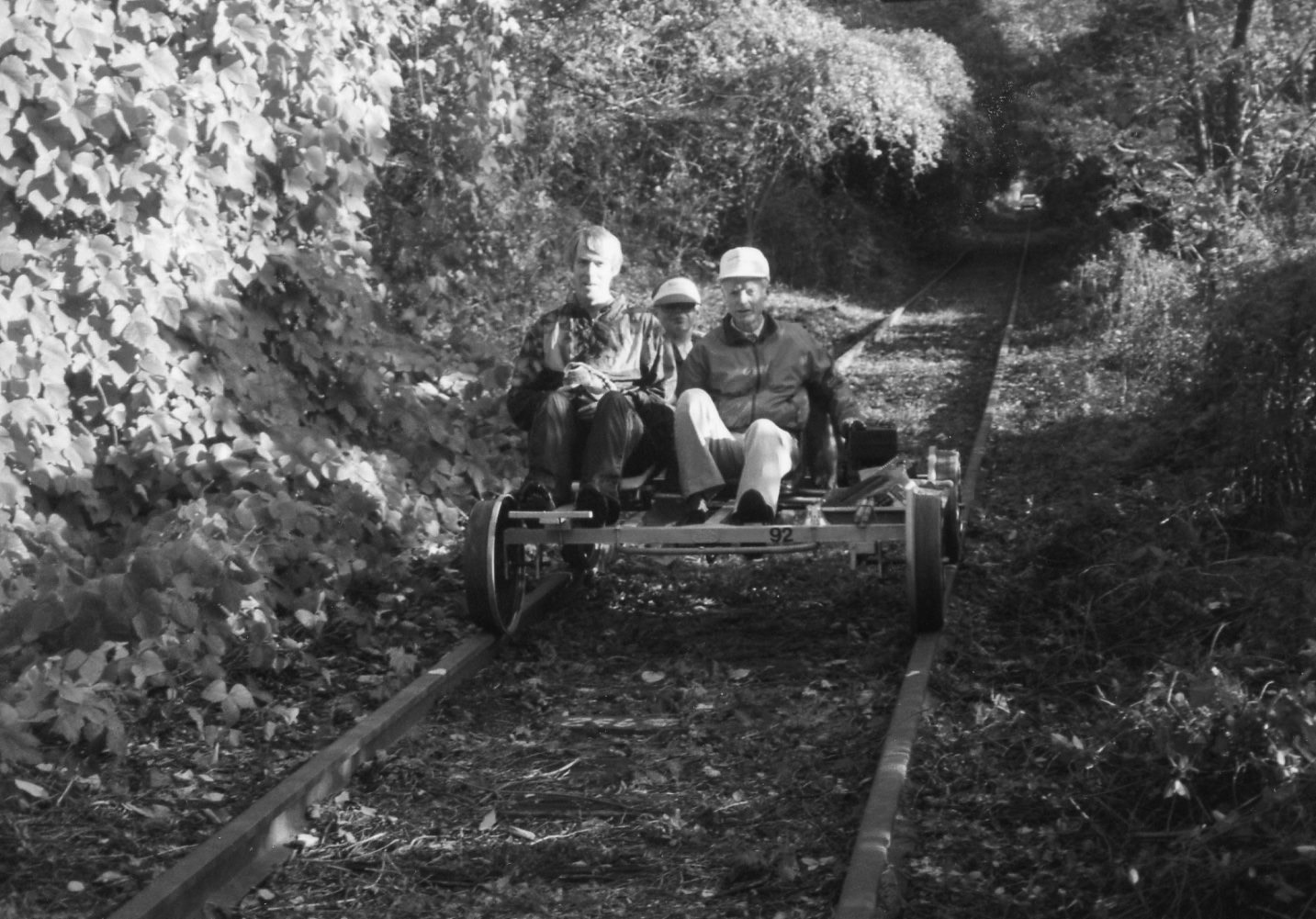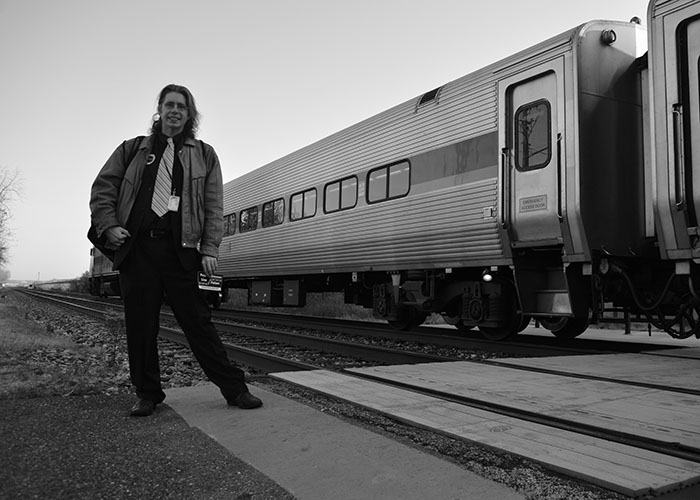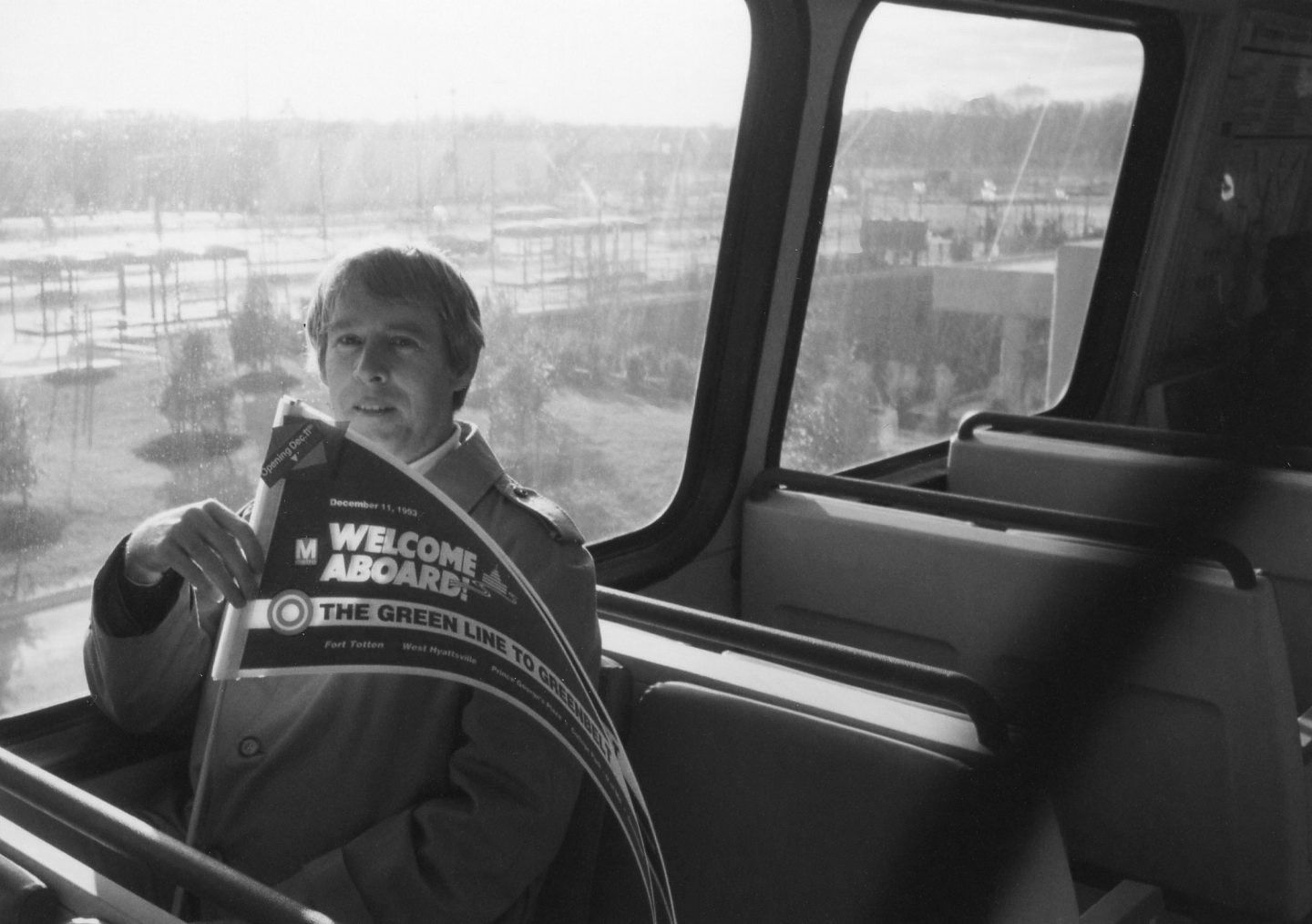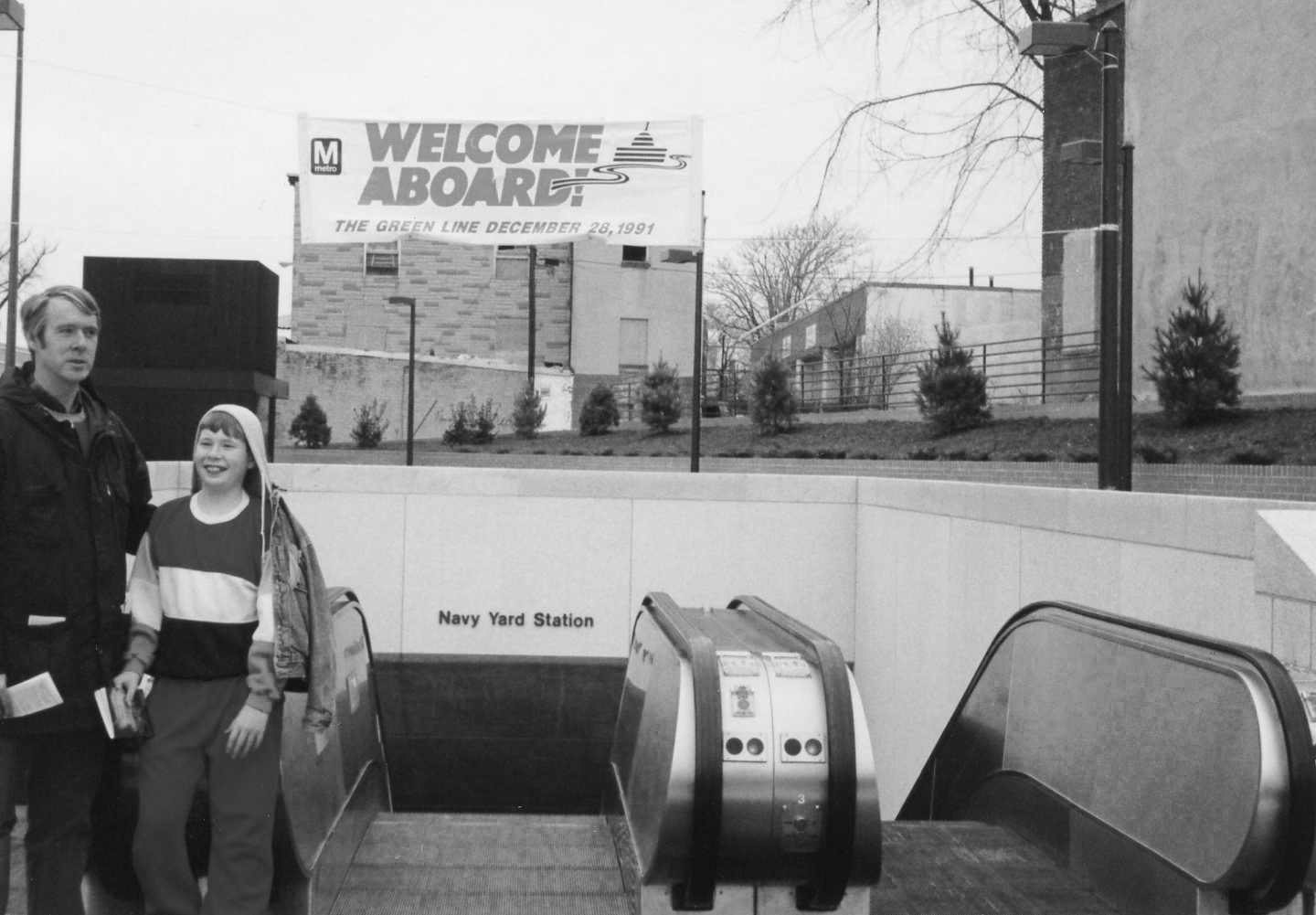April 22, 2016
The Purple Line Project Meets Pushback From Local Residents and Business Owners

Harry Sanders (far left), Gregory Sanders (back center), and an Action Committee for Transit member (far right) on a small motor driven railcar on the Georgetown Branch in Lyttonsville, Maryland. (Photo provided by Barbara Sanders)
SILVER SPRING -- When Gregory Sanders was a child, his father, Harry Sanders, would take him to the railroad tracks by their Silver Spring home. There, the two would walk the nearby state-owned CSX trail and catch sight of a coal train as it sped off to a heating plant in Georgetown, on the other end of the tracks.
It was the 1980s. Both were infatuated with the train and how fast it was. Harry Sanders, a transportation advocate, would think about how cool it would be to travel downtown by a faster, more convenient mode of transportation.
Meetings in the Sanders’s living room followed. Gregory helped his father pass out fliers about the Purple Line around Metro stations around the age of 5, his mother, Barbara Sanders, said. Harry would attend conferences on public transportation around the country on his own dime. He took transportation planning courses at the University of Maryland and visited light rails and trains around the country and in Europe while on vacation with his family -- all to study the possibilities.
Little did they know that 30 years later, Harry Sanders’ idea for better transportation near his family’s home would blossom into the Maryland Transit Administration’s newest transit project, the Purple Line -- a 16-mile light rail system with 21 stops running from Bethesda to New Carrollton.
Praised for its plans to connect Prince George’s and Montgomery counties, the $5.6 billion light rail system will accommodate transfers to the red, green and orange Metro lines, and will link to Amtrak and MARC trains. Construction is set to begin as early as later this year, with the transit line being fully operational by spring of 2022.
“Harry Sanders was a strong advocate for the Purple Line and a true champion of the benefits of an interconnected transit system,” said Sandy Arnette, spokeswoman for Maryland Transit Administration. “He understood that the Purple Line would improve mobility for tens of thousands of Maryland residents and worked tirelessly to advance this crucial project.”
Harry will never see any of it, much less ride the Purple Line. He died of kidney cancer in 2010, at the age of 63. But his family and longtime supporters are watching as the long-anticipated dream inches closer to coming true.
For others, however, it’s a nightmare.
More than 500 properties within Montgomery and Prince George’s counties will be affected by the light rail line. Some will be affected temporarily by construction, but for others, the state has been buying out properties and forcing residents and business owners to move.
Businesses in Montgomery County will be hit the hardest. Nearly 50 businesses with a little more than 200 employees are being asked to relocate.
In Prince George’s County, more than 10 businesses and 40 employees will be displaced. But the bigger impact in that county is on the residents, with more than 20 single family homes being acquired by the state.
Some business owners have known about the Maryland Transit Administration’s plans for years and are waiting for the final decisions. The Maryland Board of Public Works gave final approval of the project on April 6.
Deborah Hyman, 63, owner of the Silver Spring shop Signs by Tomorrow at the Spring Center shopping center, said her business has been at a standstill ever since she first received notice of the Purple Line’s plan to acquire her property years ago. The state, she said, is doing businesses owners a disservice.
“We cannot decide to make any renovations to our stores ... because if we choose to do that, then it could be tomorrow that we get the letter that says you have six months to move,” said Hyman, whose business has been in the strip shopping center mall on 16th and Spring streets for more than 20 years. “That affects our business because my place is getting worn down and I’m not going to put money into it if I’m going to move.”

Gregory Sanders is a long time public transit advocate and the vice president of the Purple Line Now coalition. Here, he stands at the College Park Metro station in front of a MARC train, which he takes every day from his home in Ellicott City. His father, Harry Sanders, first proposed the Purple Line. (Capital News Service photo by Brittany Britto)
Delmar Nelson, optician and owner of Crest Opticians at the Spring Center, first heard about the Purple Line more than 10 years ago and said business has since slumped off. After 50 years as the owner of Crest Opticians, Nelson is ready to retire.
“I’m just here marking time. You can’t invest in a business while you’re waiting,” Nelson said earlier this month.
Numerous partial acquisitions throughout Montgomery County will also make way for the construction of 10 stations in the county -- two of which will allow riders to transfer to existing Metro lines, at the Bethesda and Silver Spring stations. More than 70 residences will have parts of their properties affected -- some being taken, some rented, according to documents provided by the Maryland Transit Administration.
Construction for one new Purple Line station, Long Branch, will take place just feet away from Wanderly Calderon’s home in Silver Spring. The light rail will travel underground through a tunnel and will surface across from the residential parking lot adjacent to Calderon’s home.
Residents who live in the area will endure construction until it is complete. Nearby street parking will be taken and converted into a one-way street, according to the transit administration.
Calderon, a resident of Arliss Street and the president of the Arliss Street Townhome Association, said transportation officials notified her that a portion of her front yard will be taken for construction, which could block access to her front door.
“It is going to be a nightmare,” she said.
Others in the neighborhood fear the congestion the Purple Line construction could bring will be bad for business.
Carlos Perozo, president of the Long Branch Business League and owner of ZP Tax on Flower Avenue, said too much traffic caused by construction may turn his customers away. He also worries that the Purple Line will raise property and living costs, affecting a community comprised of immigrants and minorities.
“We don’t want displacements. We don’t want rent to come up,” Perozo said.
Delegate Ana Sol Gutierrez, D-Montgomery, a proponent of the Purple Line, said rising costs are inevitable, but it’s not a “Purple Line problem” -- it’s a problem of affordable housing. Local governments should study and look into the different options for people who may be priced out of the area, Gutierrez said.
We don't want displacements. We don't want rent to come up.- Carlos Perozo, president of the Long Branch Business League and owner of ZP Tax on Flower Avenue
Wise Lampkin, an 84-year-old widower from East Riverdale, Maryland, will lose his home where he created memories with his family for more than 20 years. The process of relinquishing his property has been grueling, his daughter Betty Lampkin said.
Wise Lampkin was hoping to pass his home on to his children. Instead, he’ll surrender it to the state this year.
A relocation assistance program document provided by the Maryland Transit Administration said that the owner of a home may be eligible to receive payments to help purchase a replacement home as well as assistance with any moving costs or increases in mortgage payments if asked to relocate. But the emotional effects of being relocated can sometimes be more debilitating than those that are financial.
Mindy Fullilove, a psychiatrist and professor of clinical psychiatry at Columbia University’s school of public health who has studied the effects of moving and urban renewal for the past 20 years, said moves like Wise Lampkin’s can shake up core psychological processes for the homeowners. It can trigger years of grief because, for people like Wise Lampkin, a house is not just a house -- it’s a way of life, Fullilove said.
“A house is located in a neighborhood and city. The people you know are connected to a house. All of those things are interconnected ... In a way, when you lose a space that you lived in with a (significant other), you lose the memories,” Fullilove said.
But the process of relocation is standard for major state transportation projects like the Purple Line. Many may argue that these acquisitions are sacrifices made for the greater good.
“I understand that there are places that think it is not helping or improving their personal lives,” said Barbara Sanders. “They don’t think it would work, but that’s what they said about the Metro, too.”
Barbara Sanders and son Gregory have since followed in Harry Sanders’s footsteps, actively showing support for the Purple Line project.

Harry Sanders, a transportation enthusiast, was the first person to propose the Purple Line. He dedicated more than two decades of his life to seeing the light rail project through. Here, he rides the Metro's Green Line to Greenbelt on Dec. 11, 1993. (Photo provided by Barbara Sanders)
“He had a vision that inspired other people, and he tried to work with communities to see how things could be worked through. That’s a piece of what I’m trying to do,” Barbara Sanders said.
She described her visionary husband, who hailed from the outskirts of Chicago, as very “Midwestern, conciliatory and laidback.” She, on the other hand, is more feisty and confrontational, she said.
Gregory Sanders, 36, also an advocate, said he has seen his father’s efforts manifest into his life in many ways.
Gregory Sanders takes the MARC train every day from his home in Ellicott City to his job at the Center for Strategic and International Studies in Washington. He visits public transportation systems while on vacation, just as his father had, including in Hong Kong, Japan and Egypt, and saves transit passes as mementos. He still remembers handing out literature about the Purple Line at Metro stops and festivals with his father, and walking the abandoned trails where the light rail will be.
“I don’t ever really remember him pitching me on it, but I do remember him talking to other people about it,” Gregory Sanders said. “One of the traits I strive to learn from him was that he was good at talking to a range of people and hearing them out ... without it becoming personal or angry. That can be challenging.”
Gregory Sanders has advocated for the light rail project for nearly a decade with the Purple Line Now advocacy group. As the vice president for nearly a year, he dedicates around 10 hours a week to leading the organization’s efforts to see the Purple Line through to its conception via events and promotion on social media. His involvement, he said, has been one of the proudest things he has done in his life.
“It’s ridiculous that it takes multiple generations to get it done, but I still think it was all worth it,” Gregory said.
Proponents of the Purple Line point to jobs, further development of surrounding communities and the expected decrease in commute times.
Gutierrez called the Purple Line a “social win-win” for immigrant, Latino and lower socioeconomic communities who will be able to use the light rail get to better paying jobs.
Gov. Larry Hogan’s administration predicts that the Purple Line will create more than 23,000 jobs over the six-year construction period, and will provide access to major job centers, including the University of Maryland, College Park; downtown Silver Spring; and downtown Bethesda.
The ridership is projected to include 74,000 riders by 2040, according to the Maryland Transit Administration.
State Sen. Jim Rosapepe, D-College Park, sees the Purple Line as a tremendous asset to the metropolitan area and sees the potential development as a positive for the college town.

Harry Sanders (left) and Gregory Sanders at Navy Yard Green Line opening Dec. 28, 1991. (Photo provided by Barbara Sanders)
“We want more residential and commercial developments at our Metro stop. We want more, both office development and commercial development, on Route 1,” said Rosapepe, who said that new transportation choices would provide more options for the 4,000 people working in the College Park area.
Four light rail stations are planned for College Park, including the Adelphi Rd/West Campus, UM Campus Center, East Campus and M Square Stations, connecting different parts of the college campus with surrounding areas, including the existing College Park Metro station.
Rosapepe said he sees this as a way to ease traffic and parking issues that surround major events on campus, such as sports games.
New light rail stations that will be built in Langley Park and Riverdale Park will mean that working people will have hugely improved mass transit options in the community, Rosapepe said.
Langley Park, home to one of the largest Hispanic populations in Maryland, had a 12 percent unemployment rate in 2010, the second-highest rate in Prince George’s County.
By 2040, Montgomery County is projected to have a 43 percent increase in jobs from 2010, according to a 2011 report by the Metropolitan Washington Council of Governments. For Prince George’s County, a 32 percent increase has been predicted.
Gregory Sanders said that decreasing commute time is a large part of escaping poverty.
“There is no way we can serve a range of people that need access to jobs with current options in transit, compared to what the Purple Line can do,” Gregory Sanders said.
But most of all, Gregory Sanders argues that the Purple Line will make the surrounding communities stronger and more connected. His father fought for it for a very long time.
“He was trying to bring people together,” Gregory Sanders said. “And transportation does that in a very literal way.”